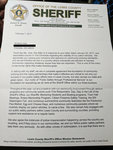


“If I can stop a crime before it happens, then I’ve done my job.”
That was the statement that struck me the most when I met with Centralia Police Chief Carl Nielsen at his office recently.
“Isn’t that kind of a high bar to set for yourself?” I asked.
Chief Nielsen didn’t think so.
He began to explain to me his view of “community policing” as a law enforcement philosophy.
Community policing is the modern philosophy of policing that is currently the preferred, mainstream curriculum taught at colleges and universities in criminal justice programs, and at the state training criminal justice academy, all the way up to the national level. Central to this philosophy is the priority of being visible in the community as a general deterrent to crime.
In Chief Nielsen’s mind, it all goes back to the “cop on the beat” — back before police cars.
According to Chief Nielsen, before police cars, police officers walked their “beats” or assigned blocks. They knew the people on their beat, and the people on the beat knew their local officer. Officers walked about freely, engaging with the community and acted as first-line problem solvers. Officers noticed when something was amiss, because they were so familiar with their beats, it was easy to spot things — or people — out of place.
Chief Nielsen believes that when police began adopting the widespread use of police vehicles, that a deeper level of community engagement and crime deterrence was lost. I also talked with Chief Nielsen about how that philosophy applied to the Centralia Police Department’s recent vehicle fleet and graphics update.
Several times during our conversation, he went back to his original quote: “If I can stop a crime before it happens, then I’ve done my job.”
Chief Nielsen explained that the department’s decision-making process came back to what deterred crime — being visible. When it came to their recent fleet update, the department chose to go back to “traditional” black and white patrol vehicles, with “POLICE” letting in black and outlined in yellow, specifically because they are widely recognized as police vehicles.
When the department originally presented their new vehicle fleet and graphics proposal to the Centralia City Council, at least one city councilor asked if the black “POLICE” lettering on the broadside of the patrol cars could be outlined in orange, instead of yellow, for Centralia “Tiger Pride!”
Chief Nielsen smiled when I mentioned this.
“There were some compromises,” he said. We chuckled as I mentioned the “tiger pride” patrol car now driven by the department’s school resource officer.
During the drafting process for the new graphics scheme, the department looked at federal law enforcement vehicle studies that determined that yellow was the most visible, attention-grabbing color (FEMA, DOJ). So, that’s what the department went with when outlining “POLICE” — to make it as visible and as recognizable as possible on the car.
It was really interesting to hear how the concept of community policing was really woven in, down to the nuts and bolts, of the department’s decision-making. And, that it was the department’s express intention to be visible, to deter crime, rather than just react to it.
That intentional visibility has extended into a series of several planned meetings between police officers and the Centralia community. The Chronicle reported on the first two meetings in the past couple of weeks.
I think all citizens should meet their local leaders, but especially their heads of local law enforcement. I would encourage any Centralia citizens with crime-related questions, concerns or interests to attend one of the two remaining Centralia Police Department community meetings planned in the next few weeks. Your options are: April 6 at City Council Chambers, or April 20 at Edison School. Meetings start at 6 p.m.
•••
I’ve received several calls and emails since my column about the Lewis County Sheriff’s Office updated fleet vehicles and updated graphics scheme published. The column and accompanying letter questioned the choice of black lettering on dark gray vehicles (known as “stealth” or “ghost graphics” by industry professionals) — and was critical of — the lack of identifiability, visibility, etc., of their new “marked” patrol vehicles.
Just to update those out there who might be wondering, Sheriff Snaza did respond to my column and five-page letter a few weeks ago. You can read his full response with the online version of this column on The Chronicle’s website at Chronline.com.
•••
Brittany Voie is The Chronicle’s senior media developer. She welcomes correspondence from the community by email at bvoie@chronline.com.